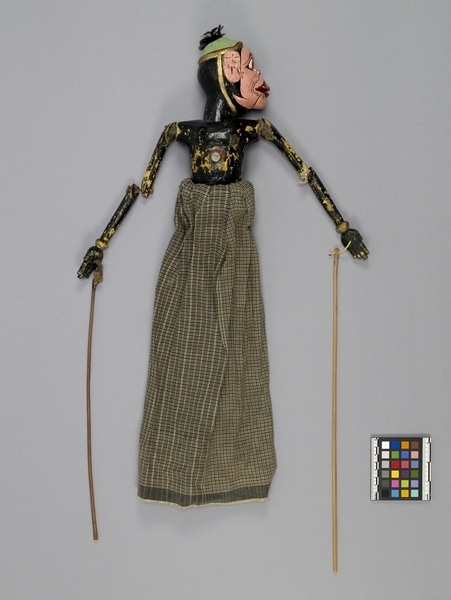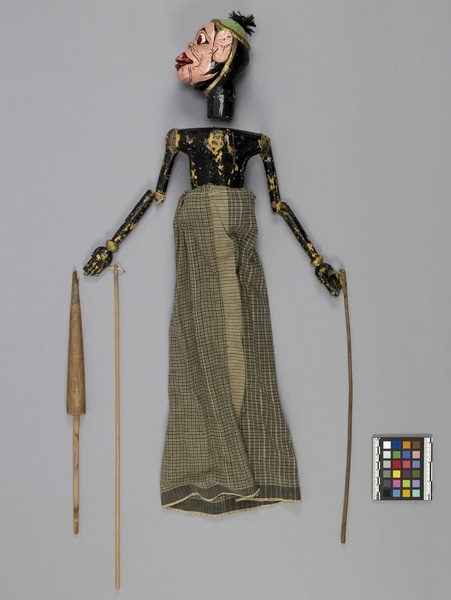Rod Puppet Item Number: Ib287 a-c from the MOA: University of British Columbia


Description
Three-dimensional male puppet: large head (part b) fits into body with skirt (part a), and a control rod (part c) with a long shaft passes through the body and fits into the neck of the figure's head. The body has jointed arms, each with a long controlling rod attached. The figure has a pink face with exaggerated features: bulging eyes with red pupils looking forward, red lips, and facial details in black. Small circular cap in green, red, and gold with tuft of black yarn at top of cap and gold strap beneath chin. Black torso, arms, and rear of head; wide shoulders and large belly with a small, circular mirror on belly that has several red and black strands of fabric or thread emerging from underneath. Arm to right tied with yellow synthetic twine (polypropylene?). One gold bracelet at each wrist; both hands held with fingers flat. Long checkered cotton skirt in grey and beige.
History Of Use
Javanese puppetry as an art form probably developed by the 11th century. Wayang golek puppets of western Java appeared during the 16th century. Originally the plays depicted Javanese mythology, but after the Indian conquest of Java the Hindu epics, Ramayana and Mahabharata, were incorporated into the cycles, which comprise about 200 plays. A dalang (puppet master) performs the plays to celebrate important occasions, usually in three acts, with vocal and instrumental accompaniment. Typically they serve a moral and religious purpose, and more recently, one of political commentary. Role of puppet unknown, description suggests it might play any number of minor roles, from servant to clown.
Cultural Context
Theatrical performance.
Iconographic Meaning
Each puppet is characterized by it's wanda, a Javanese word which describes the specific mixture of elements of size, form, colour, ornamentation and carving. Pink face, eye colour, bulging features denote little refinement and suggest aggressiveness or irreverence. Clothing inelegant. Significance of mirror(s?) unknown. Black skin indicates calmness, spirituality, or maturity. Large belly, and cap lack distinction. Character not identified, belongs to a class of unrefined characters. Possibly used in variable secondary roles.
Item History
- Made in Java, Indonesia
- Owned by Tradewind Antiques before March 15, 1983
- Received from Museum of Anthropology Shop Volunteers (Funding source) and Tradewind Antiques (Seller) on March 15, 1983
What
- Name
- Rod Puppet
- Identification Number
- Ib287 a-c
- Type of Item
- puppet
- Material
- wood, fibre, paint and cotton fibre
- Manufacturing Technique
- carved, sewn, painted, tied and woven
- Part A
- height 65.5 cm, width 14.0 cm, depth 8.5 cm
- Part B
- height 12.5 cm, width 7.5 cm, depth 9.5 cm
- Part C
- height 34.8 cm, width 2.5 cm, depth 1.7 cm
Who
- Culture
- Sundanese
- Previous Owner
- Tradewind Antiques
- Received from
- Museum of Anthropology Shop Volunteers (Funding source) and Tradewind Antiques (Seller)
Where
- Holding Institution
- MOA: University of British Columbia
- Made in
- Java, Indonesia
When
- Ownership Date
- before March 15, 1983
- Acquisition Date
- on March 15, 1983
Other
- Condition
- fair
- Accession Number
- 0886/0021 a-c